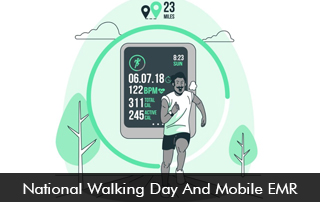National Walking Day celebrates the simple yet profound act of walking and its significant impact on health. It’s also an opportune moment to reflect on how technology, specifically mobile Electronic Medical Records (EMR), is revolutionizing healthcare delivery. In this blog, we delve into the importance of walking for health and how integrating mobile EMR systems enhances efficiency and patient care in the modern healthcare landscape.
The Importance of National Walking Day
National Walking Day, observed on the first Wednesday in April, encourages people to incorporate walking into their daily routines. Walking is one of the easiest and most accessible forms of exercise, offering a plethora of health benefits. From improving cardiovascular health to boosting mood and reducing stress, regular walking contributes to overall well-being. Moreover, it’s a low-impact activity suitable for individuals of all ages and fitness levels.
Walking isn’t just beneficial for physical health; it also fosters mental clarity and creativity. Taking a stroll outdoors can stimulate creativity, enhance cognitive function, and provide a much-needed break from sedentary activities. National Walking Day serves as a reminder to prioritize physical activity and embrace the myriad benefits of walking.
Healthcare and Mobile EMR
In tandem with the celebration of National Walking Day, the healthcare industry is experiencing a digital revolution. Electronic Medical Records (EMRs) have replaced traditional paper-based systems, streamlining administrative tasks, and improving patient care. However, the advent of mobile EMR solutions has propelled this transformation to new heights.
Mobile EMR applications empower healthcare providers to access patient information securely from any location, eliminating the constraints of traditional desktop-based systems. Whether physicians are conducting rounds in hospitals, visiting patients at home, or attending medical conferences, they can seamlessly retrieve and update patient records using their smartphones or tablets.
Mobile EMR and Enhancing Efficiency of Care
The integration of mobile EMR systems into healthcare practices offers numerous benefits, including enhanced efficiency and improved patient care. Here’s how:
Accessibility
Mobile EMR applications enable instant access to patient records, diagnostic reports, and treatment plans. Physicians can retrieve vital information in real time, facilitating prompt decision-making and reducing delays in patient care.
Flexibility
With mobile EMR solutions, healthcare providers can manage their workflows more efficiently. They can review patient histories, prescribe medications, and document encounters on the go, ensuring continuity of care irrespective of their location.
Collaboration
Mobile EMR platforms facilitate seamless communication and collaboration among healthcare team members. Physicians can share updates, consult specialists, and coordinate care plans in real time, leading to improved care coordination and patient outcomes.
Patient Engagement
Mobile EMR applications empower patients to take an active role in managing their health. Through secure patient portals, individuals can access their medical records, schedule appointments, and communicate with their healthcare providers, fostering greater engagement and adherence to treatment plans.
Efficiency and Cost Savings Through Mobile EMR
By reducing paperwork and streamlining administrative tasks, mobile EMR systems enhance operational efficiency and minimize overhead costs. Healthcare providers can allocate more time to patient care, leading to improved productivity and revenue generation.









